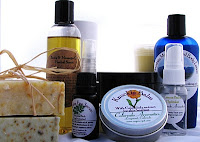
Recent stories have circulated the web about the average woman using more than 515 chemicals on her face daily implying that this was quite dangerous. This number sounded quite low to me so I thought I’d count what I use.
First thing in the morning I take a shower and wash my face with soap and water. Water is dihydrogen monoxide, the first chemical. My handcrafted vegetable oil soap will include the following oils that have been reacted with lye:
Palm oil
coconut oil
shea butter
olive oil
rice bran oil
These oils are made up of many triglycerides and their fatty acids. Fatty acids in palm oil include laurate, myristate, palmitatte, stearate, oleate, linoleate and linolinate. Coconut oil contains similar ones plus caprylic, capric, caproic and arachidic. Olive oil contains similar fatty acids plus many non fatty acid chemicals including squalene, a variety of sterols, esters of tyrosol and hydroxytyrosol, vitamin E (tocopherols), carotenoids and oleuropein. Besides the similar fatty acids listed above, shea butter also contains quite a few non fatty acid components collectively called unsaponifiables. According to wikipedia shea butter contains at least 10 phenolics including catechins. It also includes vitamins A and E. Rice bran oil again contains many phytoestrogens such as the gamma oryzanols. It also contains a unique fatty acid; behenic.
Typically I use lavender soap which contains lavender buds and lavender essential oil. According to Dr. Duke’s Phytochemical database, 76 different chemicals have been identified in lavender including nerol, linalol and limonene.
Adding all those up, I’ve applied over 107 chemicals to my face before even getting out of the shower.
What I put on my face after that can vary. But lets say I then use my parsley eye serum. The ingredient list is: organic macadamia nut oil, olive oil, meadowfoam oil, parsley extract, seabuckthorn oil and rosemary extract.
According to Dr. Dukes Phytochemical database, 204 chemicals have been identified in parsley including petroselinic acid and a mucilage (which identifies a class of chemicals rather than a specific chemical). Macadamia nut oil has many similar fatty acids as were already counted above but also contains palmitoleic acid as well as unique phenolics. Seabuckthorn oil has a wealth of chemicals including a variety of carotenoids. Some sites boast that sea buckthorn has over 30 different carotenoid types. Sea buckthorn also has vitamin K and a variety of phytosterols including beta sitosterol.
Dr. Duke’s database again helped me with rosemary showing that there are 240 identified chemicals in rosemary including cineole, betulin and carbone. Meadowfoam oil has a few fatty acids not found in the previous oils including brassic, erucic and gadoleic acids.
So this simple face treatments includes a conservative count of 581 to make a total of 688 chemicals just in the first 30 minutes of waking. I must so above average! Am I worried about applying these chemicals to my face? No. Some use the word ‘chemical’ to scare people implying that chemicals are bad. I however, know better. Yes, there are some chemicals that are toxic and should not be used.
You might notice that all of the ingredients I have put on my face are considered all natural by most people. All natural products contain more chemicals than any other products because they are so complex. If fact, the numbers stated above are much lower than they are in reality because all the chemicals found in plants have not been completely identified. Its not bad to use chemicals on your face although it may be bad to use toxic chemicals on your face.
Can you imagine using the precautionary principle and testing all the 240 chemicals found in rosemary? It could not be done. But I will not allow alarmist groups to scare me from using my skin care products and I have suffered no ill effects from this.
I’ll continue to take my chances and continue to use these safe and beneficial chemicals on my face. What about you??


Bravo! Thank you for this awesome post that is full of fact and science.
Interesting. 🙂 I use olive oil for cleansing and sugar mixed in for exfoliating as needed. I moisturize with coconut and lavender oils. Wonder what "chemicals" would be found in these. Somehow, I feel better using things I can eat.
This is my first visit. I am looking forward to reading more!
Kim, don't let the word 'chemical' scare you. Chemicals can be both good and bad. Coconut oil is a complex mix of fatty acids and other oils that might number 20 or more. Lavender has at least 70 known chemicals. The new Safe cosmetics Act of 2010 would put more stringent requirements on cosmetics than there are on food.
I use about 5 cosmetic products every morning for my face. I have mostly all natural products, so I don't really worry about harmful chemicals, because I know there isn't any in my products. My source is ingredients list. Thanks for sharing!
Anavar,
don't be so sure that there are no harmful chemicals in your natural products. Natural products can have the most complex chemistry; we just don't list the chemistry on the labels. Here is a post you might find interesting: it breaks down the chemistry of 3 natural products and how they would have to be listed on a label if the Safe Cosmetics Act passes: http://personalcaretruth.com/2010/08/report-from-dc-education-matters/
And Natural Products do include many substances that are harmful in large amounts including caffeic acid, vitamin K,caffeine and more. I don't worry about them, I just want people to know they are there because the Safe Cosmetics Act would strive to ban those toxic ingredients in any amount; even naturally occurring in botanicals.
Thanks for this! Our world would be a very non-existent place without chemicals. 🙂